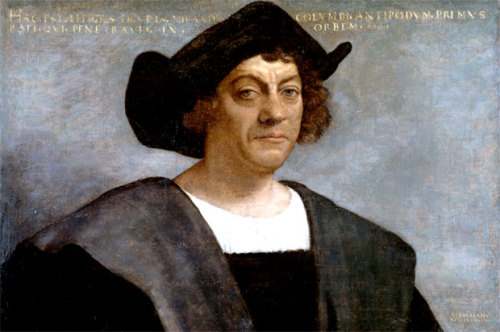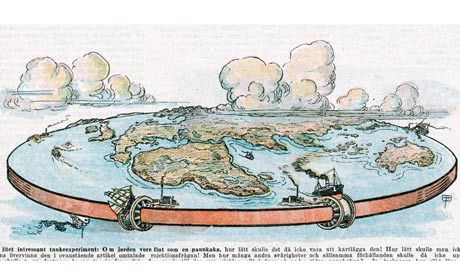peashooter85:Christopher Columbus and the Flat Earth Myth,Perhaps one of the most interesting myths
peashooter85:Christopher Columbus and the Flat Earth Myth,Perhaps one of the most interesting myths concerning Christopher Columbus’ voyage to the Americas is the notion that people living in Columbus’ time believed the world to be flat. Furthermore, it was Columbus’ theory that the Earth was round, and that he could sail across the world to get to China. Thus by conducting his voyage, Columbus proved the earth to be round and dispelled millennia of ancient and medieval humbuggery. Today the story may be taught differently in schools, but I know that as a child that was the story I was fed. Perhaps many others learned the same thing. Well now I am here to dispel this old myth, and reveal the true story, and true purpose of Columbus’ voyage.Myth #1 People believed the Earth was FlatNot true, in fact most, if not all educated people in the Middle Ages knew that the world was round. INumerous examples of Medieval cosmology depict a round planet.Even in the great Medieval work The Divine Comedy by Dante Alighieri, the Earth and the Universe are depicted as being round.Furthermore, the idea that the world is round was nothing new in Renaissance Europe. Greek philosophers and scientists such as Plato, Aristotle, and Pythagoras all taught that the world was round. In 240 BC the Greek mathematician Erosthenes not only proved the world to be round, but also calculated it’s rough circumference to 25,000 miles. He was very close as the circumference of the Earth is 24,901 miles. In later years many Greek and Roman scholars would add to his work. Even in Medieval Europe monks, philosophers, scientists, navigators, and scholars wrote or depicted a round earth. One person, named St. Bebe the Venerable, wrote in a treatise called The Reckoning of Time, which described the earth being round and was the cause of unequal lengths of daylight. Throughout the Middle Ages The Reckoning on Time was required reading at universities and monasteries all over Europe.Myth #2 Columbus was out to prove the world was round.Nope, Columbus was not out to prove the earth was round, Columbus was out to prove that he could sail to China. During the late Middle Ages the Ottoman Turks restricted trade along the Silk Road to China. Worse yet China became an isolationist empire, refusing to allow the exportation of goods through the Silk Road. Columbus believed that he could bypass the Silk Road by sailing west across the Atlantic. As a navigator, Columbus certainly would have known the world to be round. After all, navigation equipment of the day were designed to be used with a round earth, such as the quadrant,and astrolabeIf the earth was round, Columbus’ tools and navigational techniques would have all been useless.Myth #3 Kings and Queens refused to sponsor Columbus because they thought he would sail off the flat of the Earth.Before Columbus gained patronage with King Ferdinand and Queen Isabella of Spain, Columbus requested expeditions from the French, English, and Portuguese. One common myth was that Columbus was denied sponsorship because people believed the Earth was flat, and that Columbus would sail right off the edge. Of course by now I should have solidly disproved the idea of a Medieval flat earth. Of all people, Kings and Queens would have known the earth was round, being educated themselves or having access to highly educated advisers. The rulers or Europe did not grant Columbus an expedition for that reason. Remember the Greek mathematician Erosthenes and how he proved the Earth to be round? Remember his calculation that the Earth was 25,000 miles in circumference? Columbus believed the Earth was smaller than what Erosthenes had calculated. In fact he believed the distance from the Canary Islands to Japan to be only 3,000 miles, while in reality the distance is more like 19,000. Columbus believed this because he was an avid follower of the geographer Paolo dal Pozzo Toscanelli, who believed the Atlantic Ocean looked something like this…As a result the monarchs of Europe scoffed at Columbus’ idea. While Columbus insisted China was a mere 3,000 miles away, the monarchs of Europe knew that it was much farther, and for all they knew, there could be nothing but 19,000 miles of open ocean between Europe and Asia. Neither they nor Columbus had any idea, or at least had very little idea, that there was a whole unexplored continent in between.Columbus’ crew mutinied because they feared they were going to sail off the edge of the world.On October 10th, 1492 Columbus’ crew grew near mutinous from fear after over two months of voyaging. Going with the old myth that they feared sailing off a flat earth, they demanded Columbus turn around to avert disaster. Columbus promised them they would head home if they did not sight land within two days. This mutiny of Columbus’ crew actually did happen, but they were not afraid of a flat earth. Again, being experienced seamen, they would have known well that the earth was round. So what were they afraid of? Remember that if Columbus was wrong, they were only be at the beginning of a 19,000 mile voyage over open ocean. There were no friendly ports nearby, they had not sighted land in two months, and they had no idea what lied ahead. So what were they afraid of? All of the things sailors are typically afraid of; storms, starvation, disease, scurvy, dehydration, shipwreck, and drowning. Wouldn’t you be afraid?The Origins of the MythIn 1828, Washington Irving wrote a biography of Columbus. Not a scholarly work, Irving completely fictionalized much of the biography. As a result many myths were propagated, including the flat earth myth. Eventually the myth was parroted by other writers, as well as historians, teachers, and scholars. The myth was further embellished in the mid to late 19th century when scholars made the claim that the medieval church believed the earth to be flat, an anecdote which scientist used in the debate over science vs. religion. Eventually the myth became “truth” and decades worth of historical damage was wrought. -- source link
Tumblr Blog : peashooter85.tumblr.com


